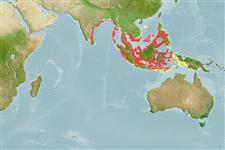Common names from other countries
>
Ovalentaria/misc (Various families in series Ovalentaria) >
Opistognathidae (Jawfishes)
Etymology: Opistognathus: Greek, opisthe = behind + Greek, gnathos = jaw (Ref. 45335); to the very elongate upper jaw of the type species of the genus, Opistognathus nigromarginatus (Ref. 128653); cyanospilotus: Nmae from Greek 'kyaneos' meaning dark blue and 'spilotos' for spotted, in reference to the characteristic blue markings on the head..
Environment: milieu / climate zone / depth range / distribution range
Ecología
marino; rango de profundidad 12 - 30 m (Ref. 81517). Tropical
Distribución
Países | Áreas FAO | Ecosistemas | Ocurrencias, apariciones | Point map | Introducciones | Faunafri
Eastern Indian Ocean: Thailand (Andman Sea) and Indonesia (Sumatra).
Tamaño / Peso / Age
Maturity: Lm ? range ? - ? cm
Max length : 13.0 cm TL macho / no sexado; (Ref. 81517); 11.6 cm SL (female)
Short description
Claves de identificación | Morfología | Morfometría
Espinas dorsales (total) : 11; Radios blandos dorsales (total) : 15 - 16; Espinas anales: 3; Radios blandos anales: 15; Vértebra: 29. This species is distinguished by the following characters: moderately elongate supramaxilla and mostly rigid maxilla with only a slight flexible lamina posteriorly extending about 0.9-1.2 eye diameters behind posterior margin of orbit; D XI,15-16; A III,15; vertebrae 10+19; gill rakers 11-12+21-23; infraorbitals are moderately robust, the second and third with large sensory canal openings, third infraorbital with large suborbital shelf; lateral-line ends below verticals between sixth to eighth segmented dorsal-fin rays; caudal vertebrae 19. Colouration: upper jaw's inner lining and adjacent membranes with a black blotch; when alive, the opercle, cheeks and upper jaw with prominent blue spots or blotches; no dark blotches on body and dorsal fin (Ref. 81517, 128653).
Found in sand/rubble bottoms among reefs in 12-30 m (Ref 90102).
Life cycle and mating behavior
Maturities | Reproducción | Spawnings | Egg(s) | Fecundities | Larva
Smith-Vaniz, W.F., 2023. Review of Indo-West Pacific jawfishes (Opistognathus: Opistognathidae), with descriptions of 18 new species. Zootaxa 5252(1):1-180. (Ref. 128653)
IUCN Red List Status (Ref. 130435)
CITES (Ref. 128078)
Not Evaluated
Threat to humans
Harmless
Human uses
Herramientas
Special reports
Download XML
Fuentes de Internet
Estimates based on models
Preferred temperature (Ref.
115969): 28.2 - 29.2, mean 28.8 (based on 142 cells).
Phylogenetic diversity index (Ref.
82804): PD
50 = 0.5000 [Uniqueness, from 0.5 = low to 2.0 = high].
Bayesian length-weight: a=0.00389 (0.00180 - 0.00842), b=3.12 (2.94 - 3.30), in cm Total Length, based on all LWR estimates for this body shape (Ref.
93245).
Nivel trófico (Ref.
69278): 3.5 ±0.6 se; based on size and trophs of closest relatives
Fishing Vulnerability (Ref.
59153): Low vulnerability (10 of 100).
